If you’re looking at establishing a hedge in your landscape, Australian natives make for excellent hedging options. Australian gardens can face some pretty harsh soil and climate conditions that many exotic plants struggle to thrive in whereas native hedge plants are well adapted and suited to our conditions.
There is a plethora of beautiful native varieties to choose from, each offering certain unique growing qualities, colours and textures. Here is your full guide to the best Australian natives for hedging.
More...
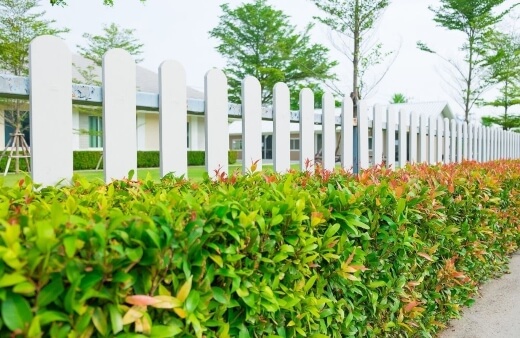
A hedge can offer both functional and ornamental applications within a landscape. Whether used for structured privacy, wind protection or as a living fence, a luscious green native hedge can look great in almost any Australian garden.
When considering a hedge, you should have a good understanding of the size, growth speed and flowering type that would suit your needs best. Luckily, there are many captivating cultivars to choose from. Here are our picks for the top natives for hedging.
Benefits of Australian Native Hedge Plants
It’s easy to see why many of our native plants have become very popular hedging choices. Being well adjusted and secure in our environments, these hardy plants can be very attractive and useful additions to your landscape.
Here are some of the benefits of using Australian native hedge plants:
- They are very well suited to our sometimes-harsher climate conditions.
- They require less maintenance and water compared to exotic varieties.
- They are hardy, drought-tolerant and adaptable to different soils and growing conditions.
- Most are resistant to many pest and disease problems.
- There are so many beautiful varieties to choose from so there’s bound to be the right hedging option for you.
Top Australian Natives for Hedging
Many native varieties are used as hedges and stand out as clear favourites in many regions, being widely used throughout Australia and other countries overseas with similar conditions to ours. Here are our top picks.
Lilly Pilly Hedges

Source: onlineauthority.com.au
It is important to note that the Acmena genus, commonly referred to as Lilly Pilly, has many different botanical names including Eugenia, Acmena and Syzygium.
All these species make for excellent hedging options that can also look great in wild gardens as they tend to attract native birdlife with their oftentimes colourful flowers and edible fruits.
These plants can generally grow in narrow spaces and they grow with a dense, bushy habit. They respond well to pruning and have a large array of cultivars catering to any style of hedge.
The smooth, glossy green leaves can suit both formal and relaxed garden themes.
- Acmena smithii ‘Allyn Magic’ – Has a naturally compact growth habit and is an all-around adaptable plant.
- Acmena smithii ‘Cherry Surprise’ – This cultivar features beautiful burgundy growth that will work great when used as part of a feature hedge. The compact growth habit makes it a suitable hedging option and this variety is perfect for taller hedges as it is a taller growing.
- Syzygium francisii (Giant Water Gum) – Ideal for low, formal hedges.
- Syzygium australe (Scrub Cherry) – Offers colourful and rich foliage with attractive fruits and flowers. Its slender growth makes it good for narrow spaces.
- Syzygium paniculatum (Magenta Cherry) – With soft, green textured foliage and wispy, colourful white flowers, this variety also produces bird-attracting edible fruit and makes for a good ornamental hedge.
Here is our in depth guide to growing Lilly Pillies.
Westringia Hedges
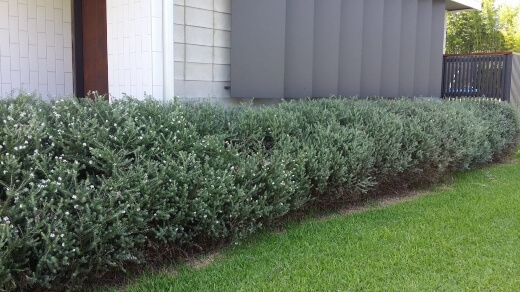
Source: gardendrum.com


Get Your Free Guide:
Master Growing Australian Natives eBook
A Must Have Complete Guide for Every Australian Garden
Get Your Free Guide:
Master Growing Australian Natives eBook
A Must Have Complete Guide for Every Australian Garden
These hardy, long-lived, flowering natives make for wonderful box or topiary hedges and can tolerate a large range of soil types and climate conditions. They respond very well to pruning and their natural dense growing habit makes them ideal for hedging. To help with you with forming that perfect hedge, check out our comprehensive hedge trimmer buying guide.
Great for coastal or arid areas, these plants feature dark green foliage with a sleek silvery tint. The small leaves allow for pruning into tighter shapes so these plants are perfect for those who prefer more well-kept, orderly natural spaces.
If you’re looking for a drought tolerant Australian native hedge, one of the many beautiful Westringia cultivars may be the perfect pick for you.
- Westringia fruticosa ‘Smokey’ – With a tough nature and subtly variegated foliage that shimmers with silvery hues, it's no wonder this cultivar has become such a popular choice when looking at Australian native hedge plants.
- Westringia fruticosa ‘Seafoam Swell’ – Loved for its profuse flowering and compact growth habit, this variety also features silver-grey foliage. Resistant to drought, frost and periodic wet feet.
- Westringia Naringa – For a taller hedge, this variety would work great. It will grow to about 1 to 2 metres and is naturally dense and compact.
- Ozbreed Aussie Box Westringia – An excellent medium-sized dense box hedge that is a good alternative to the English box. Both the Aussie Box and Naringa varieties feature dark-green leaves with a grey hue and both produce masses of mauve flowers.
Here is an in-depth guide on how to grow and care for Westringia in Australia.
Callistemon Hedges
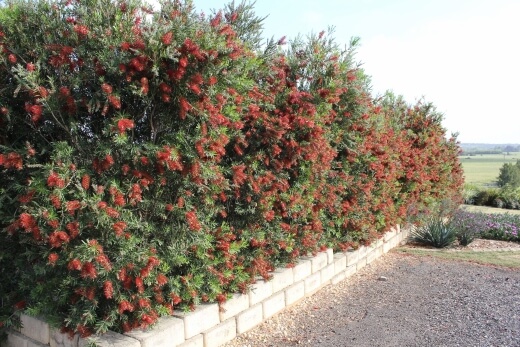
Source: digplantco.com
These bottlebrush varieties are also good choices for hedging. With luscious, wild and colourful floral displays that can attract local wildlife, these plants also feature ideal dense growth and are extremely drought-tolerant plants.
They can grow in full sun to partial shade and suit most soil types. These plants thrive on regular pruning so larger varieties can also easily be controlled to produce tighter growth habits.
- Callistemon ‘All Aglow’ – The bright, lively new growth features vibrant purple to pink flowers. This cultivar is highly adaptable and can tolerate heavy clay soils.
- Callistemon ‘Great Balls of Fire’ – Loved for its bright reddish-pink new growth and compact growing habit, this plant makes for an excellent showy hedge.
- Callistemon viminalis – There are a few great viminalis varieties available for hedging. These plants are perfect for small to medium hedges that require minimal care. The vivid displays of new growth last for long periods and these plants produce abundant flowers as well.
More Australian Native Hedge Options
There are a few other excellent Australian native hedge plants that might be the right hedging options for your needs. Whether it’s for their unique colours, foliage or growth habits, these plants can also make for good hedges in Australian gardens.
Here are a few honourable mentions for the top Australian natives for hedging.
Native Australian Hedges with More Splash of Colour

Photinias are quick-growing, hardy plants that are a fantastic choice for those who are looking at a colourful Australian hedge. With vibrant, fiery red foliage, wonderfully white flowers and red (inedible) berries, this popular ornamental shrub is a great addition to gardens that need a burst of colour.
The beautiful array of coloured growth is accompanied by luscious dark green foliage and with over 60 species to choose from, photinias offer plenty of variety for hedging.
These plants are easy to grow, low-maintenance, and can thrive in many soil types and climate conditions. Click here for a detailed guide on how to grow and care for Photinia robusta.
Best Hedging Options for Poor Soil
If you struggle with your soil quality and have low soil nitrogen in your garden, one of the many Acacia species can also make for great hedges in poorer soils. They have nitrogen-fixing qualities and you’ll most likely be able to find a species that is endemic to your local area, meaning it will easily thrive and grow well in your landscape.
Fragrant Australian Native Hedges

For those who want to establish a fragrant, drought tolerant Australian native hedge, one of these beautiful cultivars may be of interest. The orange blossom, Murraya paniculata, produces delicate white flowers with a magnificent scent making it a great choice for a fragrant hedge.
Sometimes referred to as orange jasmine, this plant will grow best in full sun to part shade and in well-drained soil. Another obvious choice for a functional fragrant hedge would be Leptospermum ‘Little Lemon Scents’.
The wonderfully aromatic lemon-scented fine foliage is a stand-out feature and the compact growth habit of this plant makes it ideal for hedging.
Adaptability & Low-Maintenance Native Hedges
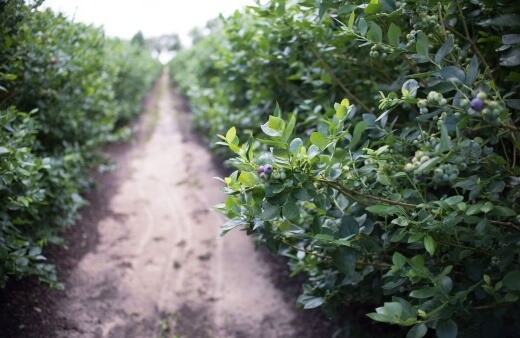
Perfect for tropical regions, the blueberry ash, Elaeocarpus reticulatus, is a good low-maintenance hedge that can look fantastic year-round. This small tree produces pretty flowers, small blueberries and red to green new growth that offers gorgeous displays in season.
In more non-tropical regions, the Camellia sasanqua is a suitable alternative that offers the same hedging benefits. For a very adaptable plant that can thrive and flower in sun or shade, the Leionema ‘Green Screen’ is the stand-out choice.
With its masses of white flowers and ideal compact growing habit, this plant truly looks fantastic in any natural space and makes for a great hedge.
Check out our comprehensive guide on how to grow a camellia hedge in Australia.
Wild Native Hedging
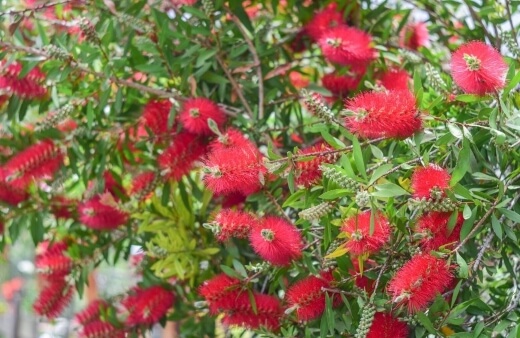
If you’re keen on attracting birds and other wildlife to your garden, these hedging options make for excellent additions to wilder gardens. Callistemons are great for attracting native birds and adding that wild touch to natural spaces. However, if callistemons aren’t your thing, one of the many Grevillea species would also be a great choice.
Many Grevillea varieties offer a large selection of flower colours and foliage textures so there’s bound to be a grevillea to suit your gardening needs. These plants are also a little more resistant to frost than callistemons.
Low to Medium Native Hedges
Many of the Melaleuca varieties and cultivars are excellent for low to medium hedges. They also offer colourful, variegated foliage and easy-going attitudes.
A very popular cultivar for hardy, low-maintenance short hedging would be the Melaleuca linariifolia ‘Claret Tops’. Widely used for its lively red new growth and ideal growing habit, this plant is perfect for those who don’t need a very tall hedge.
Quick Tips for Planting Australian Hedges

- Generally, the bigger the species you use for your hedge, the further apart you should space each plant when laying your hedge.
- Low hedge plants that grow to 1 to 1.2 metres can be spaced 50cm apart when planting whereas taller varieties should be spaced about 1 to 1.2 metres apart.
- Be sure to always first check the laws and local legislations in your area regarding which species you are allowed to plant as well as how tall or big your hedge can be.
- Australian native hedge plants generally respond very well to pruning so be sure to stick with a healthy pruning routine to get the most out of your hedge.
- These natives also normally grow best in well-drained, quality soil and the use of rich organic compost can also be beneficial while establishing your hedge.
Australian Hedging FAQs
What is the fastest growing hedge in Australia?
Viburnums are very popular choices in Australia as fast-growing hedges. Viburnum tinus is an excellent evergreen variety that features small leaves and it grows to a good height of about 3.5 metres.
The larger leaf Sweet Viburnum has larger, shiny emerald leaves and produces attractive fragrant flowers. Here is everything you need to know to grow and care for Viburnum odoratissimum in your garden.
What native plant makes a good hedge?
Callistemons and Westringias have been extensively bred and cultivated to offer a wide range of forms and colours for hedging. Their natural dense-growing habits make them excellent native alternatives for hedges.
Does Lilly Pilly have invasive roots?
Whether a small bush or big tree variety, the lilly pilly root systems are generally non-invasive.
Looking for more hedging inspirations? Check out our list of mixed hedging plants.

Create a Vibrant Landscape with Australian Native Hedge Plants
With so many amazing Australian native hedge plants to choose from, it’s easy to see why so many growers and homeowners choose to use these natives as hedging options in their landscapes.
Being easier to care for and well suited to grow in our harsher climate conditions, these plants are an obvious choice for Australian gardens. Regardless of what kind of hedge you’re looking for, Australian native hedge plants are certainly worth considering for your hedging needs.
Published on April 14, 2022 by Nathan Schwartz
Last Updated on September 19, 2025

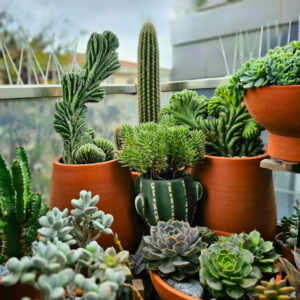
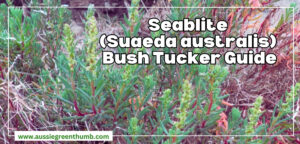
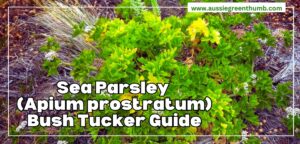

Hi AGT
Many thanks for your great website – such helpful information.
We have just purchased a home in Avalon Beach NSW on rocky land. As a public walkway runs alongside our property, I'd like to plant some native hedges for privacy. What is the best native to choose for rocky ground? I haven't tested it yet, but I'm concerned that the soil depth may be slightly shallow.
There are several trees on the property, including well-established gums, so I assume planting something like Lilly Pilly should be ok?
If you don't think this is the best idea, I'd be grateful for your advice on a fast-growing native to provide some screening.
On a related note, a very amorous bush turkey loves this property, and I want to make sure he doesn't dig up newly laid soil for his romantic nest-building activities – any suggestions?
Many thanks
Amanda
Hi there Amanda,
I’m so happy to hear our content has been useful for your gardening needs and congratulations on your new home. Yes, a lily pilly hedge could certainly work well in your area. I would recommend Syzygium smithii (also known as Acmena smithii). This species is one of the best natives for hedging and is tolerant of salty air and sandy soil so long as the soil is well draining.
Alternatively, Westringia fruticosa is another hardy and dense native, excellent for hedging and screening. It is also perfectly suited to coastal NSW. Lastly, Callistemon is also good for tight planting areas so your shallower soil shouldn’t affect its growth.
When planting in shallow soil, you can consider mounding up the soil over the root ball of the plants you sow. You can also add a healthy layer of composted topsoil and water well before planting. Regarding your brush turkey friend, to deter the females from laying eggs in your soil, it is important to make it difficult for them to rake the ground.
Here are a few ways in which you can do this:
•Time your work to ensure you are around when the turkey is looking for mounds or building one.
•Place small rocks or tree guards at the base of plant stems.
•Cover the area with large, heavily branched sticks and tree loppings.
•Use heavier mulches that are not easily raked.
•Use rocks combined with some low-growing or clumping plants at the base of plants to provide natural barriers. Good examples would be Dianella and Lomandra.
•Lastly, you can place a layer of chicken wire just below the surface of mulches or the topsoil (about 2mm deep). Brush turkeys despise the feeling of raking wire so this will force them to seek optimal habitat elsewhere.
I hope this information can help you guys establish a beautiful native hedge while deterring your garden turkey from nesting.
Happy gardening!
Nathan Schwartz